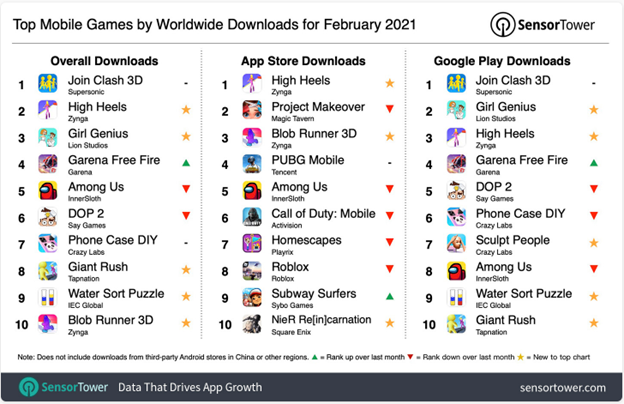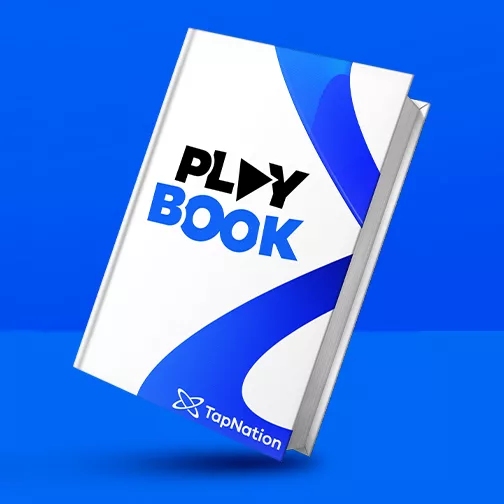
Hypercasual games have exploded onto the gaming scene, and quickly demonstrated the unrivaled competitive advantage of elegance and simplicity.
The term itself became popular in mid-2018, when the bouncing ball game with rotating towers Helix Jump blew up in the mobile market and became the most downloaded game of 2018, surpassing Fortnite and PUBG with 334 million downloads. Whether it was a coincidence or not, the popularity of this game took place at the same time as the introduction of the new term “Hypercasual game” into the game designer’s list.
It is essential to grasp a deep understanding of the appeal of hypercasual games before trying to create them. The term “Hypercasual” refers to mobile games that are lightweight, minimally designed, and can be created quickly while providing a high level of engagement and replayability. Use minimalist, straight forward interfaces and tried-and-true design principles to attract the greatest number of players.

Our aim here isn’t to guide you into making a Hypercasual game today. We strive to tell you how to create successful Hypercasual games that will stand the test of time, won’t get lost in the crowd, and will earn a lot of money.
Are you ready to jump right in? Then let us proceed and make our way to the VIP list of Google Play and App Store as short and as fast as possible.
Let’s look at these steps and understand the process of development:
- Game Design
- Game Art
- Game Development
- User Acquisition
- Game Monetization
- Tips for getting published
STEP 1 – GAME DESIGN
(A) BRAINSTORM IDEA
A good brainstorming isn’t just throwing random ideas.
At first you should analyze the current trends of the market. Then each person taking part in your brainstorming process should try to find what is the key element in those trendy games. The simple, intuitive element that attracts players (game mechanics, art style, settings, etc. …). After this analysis, try to put as many ideas as possible on paper.
Remember that when brainstorming you should always focus on the potential of an idea rather than its risks. All ideas should be accepted at first, no matter how crazy and difficult they might be. Difficulty and risk assessment is for later, you should keep an open-mind during brainstorming, and start from the theory that all the concepts could become hits. Usually at this point, some ideas will already be more appealing / more popular than the rest.
Then try to elevator pitch the idea to someone who wasn’t in the brainstorming, and watch their reaction: do they understand the concept? Do they visualize it? And are they hyped by it?
Tips by TapNation Dev. for Gaming Ideas:
Snackable:
Hypercasual games are played a couple of minutes per day spread on multiple small sessions. Those games are played while waiting or on the road, and thus players should be able to stop the game without being penalized in their gaming experience. To do so, small levels of a minute or two are best suited for the Hypercasual players.
Intuitive:
Hypercasual games are made so that everyone can play them, and thus should be accessible to anyone. The more intuitive, clear and straightforward your game looks, the more people you can hope to attract.
Flattering Visuals:
Players will most likely come to playing your game by seeing it in an ad. It’s in the first 3 seconds of the ads that you are most likely to convert a viewer into a player, so you better make the game as visually appealing as possible to stand out.
Reward Player:
Each session you play should feel like a Jackpot in a casino. But since playtime in Hypercasual games are short, you want to make sure your player gets their jackpot, their satisfaction, no matter how long they’ve played. And the best way to do it is to plan as many satisfying elements as possible (rewards) obtainable throughout the game. Little Jackpot, big jackpot doesn’t matter, as long as players are gaining something for everything they do in the game.
Introduce Obstacles progressively:
First 3 levels should always be super easy. Starting from level 4, obstacles and new gameplay elements should arrive progressively, and one by one. You don’t want to burn all your content within the first 5 levels.
Create Maximum levels:
To keep players around for the longest time possible, you need to create a habit of playing your game in the player’s life. Something to play “a couple of levels every morning”. But unlike habits, you don’t want the players to play consistently the same level. You still want to create novelty while staying true to the reason the player downloaded the game in first place. And the best way to accomplish that is to make as many levels as possible with small variations between each of them to create a good surprise/habits ratio.
(B) 3C & CORE MECHANIC
Once the development of the game starts, the first thing that you should spend time on are the 3C (Character, Camera, Controls). The 3C are what the player will see / use 90% of the time in your game, so you want them to be as polished and satisfying as possible.
If you manage to optimize the 3C close to perfection, the rest of the game will be bonus. Because only interacting with the character will be satisfying in itself.
For the core mechanics: think depth rather than diversity. Once you have your core mechanic, think about the different situations you could use it in.
Archero is the best example in that case: the mechanic is always the same (Hold and drag to move / stop to start shooting). But by adding random tweaks on this core gameplay via the random upgrades, it will change your entire playstyle, while still using the same mechanic.
Another good example is Mario. In Mario the core mechanic is to jump to survive, you must first learn to jump above holes and obstacles. Then you discover that you can jump and hit bricks to find bonuses… And afterwards learn to time and control your jump, and land on enemies to kill them. So, in the end, there is only one mechanic (jumping), but depending on how you use it, you can explore, gather or kill.
In conclusion: for the prototyping phase, focus on the 3C and the core gameplay. If those elements are perfect, 90% of the game is done, and the rest is just polishing and making it look better.
STEP 2 – GAME ART
(A) ART DIRECTION
Art direction can be a game changer in our quest for the best CPI. Some art directions are best suited for specific types of games. This is not an absolute truth (there are always exceptions) but for instance games about cars perform better with realistic graphics. Whereas games like runners perform better in a cartoon / low poly art style.
Testing different art directions early is a good idea to understand what your audience’s preferences are. It is important to benchmark your game, and verify what is the most recurring art style for a given game genre. You might think that it would be best to do things differently in order to stand out. But in general, there is a reason why all the competition goes for a similar art style for a specific genre (because it works).
However, it shouldn’t mean that you should copy exactly the looks of similar games. You can choose the same art direction (ex: cartoon) but still manage to express your uniqueness in the way you do it. Shortcut Run and Wacky Race are both in cartoon style, but are nothing alike. Differences can be through the colors, the environment, the animations, character… while remaining true to the same art direction.
STEP 3 – GAME DEVELOPMENT
(A) DEVELOPING FIRST PROTOTYPE
When it comes to game design, elements such as core game mechanics and dynamics must be present from the start, regardless of how simple your prototype is. If you’re thinking Hypercasual, you’ll want your games to be satisfying from the start, so the visual and rewarding aspects should be present before attempting any tests.
At the prototyping stage, visuals must not only be appealing but also have high readability to ensure that creatives are understandable in about two seconds. Remember that the first test is where you’ll get a first glimpse of a game’s marketability and ability to scale, so make sure the visuals, gameplay, and overall feelings are all there from the start and are showcased in the best way possible, as this will manifest in better CPIs.
(B) PROJECT TEMPLATE
The realization of a project template allows to organize and accelerate the development of the game, it also allows to very easily improve the different parts of the game and to add content. Here are some important points to make a clean project for your games:
Automation
The automation can be done on several elements of your game, first of all the generation of levels. When testing your game, a small number of levels will be needed, but when you want to increase the content of your game to improve retention, the automatic level creation will allow you to do it very quickly. Moreover, it will be much easier to modify the level generation code to apply a level design change rather than modifying all your levels one by one to adapt them to the new level design.
Automation also means the creation of tools that will allow you to create your next game more easily. For example, if you make a runner, you can directly create tools to make your game (character control, animation, level creation, score menu …). These tools can be used as templates to create new prototypes much faster. And so on.
To do this you will have to make sure that your project is well ordered, especially in your folders. In your Asset folder you should only put the most important folders that will serve as categories for all your assets, do not put assets in the root of your folder, put them in the right category. Your hierarchy can quickly become confusing so be careful to organize everything well.
Make your projects so that they can be reused, not just by you.
Development Tips – To Improve Game Performance
In order to improve the performance of your game there are several points to consider.
You should absolutely avoid putting loops and greedy code in the update functions. To avoid redundant code in the update you can call them once and store the result in a variable, for example if you want to retrieve a variable in remote, you should retrieve the value only once and then store it in a variable that you can use in your update. To remove loops in the update you can use Coroutine or Jobs to distribute or parallelize the work so that it is not blocked.
An important part of the performance can come from the physical rendering of your game, for that there are several things to do in order to lower the computation time.
- Enable adaptive force
- Increase Time Step
- Don’t use Mesh collider but primitive collider
- Replace GameObjet with rigidbody by entity
The last step to improve the performance of your game is to improve the rendering time. To do this you need to work on and optimize your mesh. Reduce the number of polygons, don’t have any holes and make sure that all the triangles are well connected to avoid duplicating unnecessary vertices. Compress your textures as much as possible if they don’t have too many details or if they can be tiled (keeping a power ratio of 2 in size in order to optimize the use of the graphic memory). Moreover, it is important to reduce the number of GameObjects for a model.
Programming and debugging tips
Design patterns are a very important programming tool that will allow you to solve a large part of the programming problems you may encounter. They will also allow you to improve your creativity by opening you to new possibilities.
Here is a list of patterns that will be very useful:
- Observer pattern
- Command pattern
- Singleton pattern
- Flyweight pattern
- Composite pattern
It is very important to use GIt in order to version your code, because in case of a problem then you will be able to go back, it will allow you to work more easily in a team but also to work at the same time on several versions of your game without slowing down the others by switching from one to the other. It allows you to have a history of all the versions of your game, as well as all of the changes that may have been made by your team and yourself.
Visual studio provides a debugging tool that will allow you to add breakpoints of your player to be able to see the state of the variables when you want, you can also run your code step by step.
Unity gives access to a very useful debugging tool when your game is built on your phone: Android logcat, this tool will allow you to see the logs of your game in real time.
Every year, we test hundreds of prototypes at TapNation, working closely with studios all across the world. We provide studios with insights and advise game creators on how to develop a successful Hypercasual game for a long run and how to build amazing games through our Publishing Platform.
We are adding this game development guide to our platform. Our platform provides game developers and studios a more technical framework to develop a successful game which will assist you in saving time on iterations, improving game performance and KPIs, especially while scaling your game, and improving your team efficiency.
STEP 4 – USER ACQUISITION
SOFT LAUNCH AND TESTING
Before launching your game on the market, it is necessary to test it for a number of aspects. This is the main goal of a soft launch. It gives a possibility to test on a small part of its potential audience the different components of the game that you want to confirm. User experience or FTUE (First Time User Experience), monetization, retention… for each step there is a soft launch phase. A soft launch aims to have a maximum of insights with limited cost, without losing its audience.
How to Soft-Launch
There are as many strategies for Soft-Launching your game as there are games. The key to success is to tailor your optimization to the performance and data your game yields.
Our advice is to start your Soft-Launch with high caps and tailored target bids. It is essential that these bids be set according to all the data learning you experienced from testing your game. These campaigns are of course adjustable according to the traffic you are seeking.
In the first few days of soft launch, as you gather some learning you can start bidding progressively to a higher target bid. It is essential that you continue working on the product during Soft-Launch to keep improving your LTV, thus leaving more room for UA to access higher CPI bids.
On another note, we highly recommend (in order to maximize your installs per thousand of ads impressions) to carefully consider your launch localization and timeline. In the most probable case, you will be launching in high tier countries, analyze the data from the first few days of your Soft-Launch and then launch your game completely in the country that your learnings point out as being the most promising. The most common practice for Soft-Launch is to launch in the US, and if your data doesn’t show sufficient learnings to choose another geographical launch, that’s what you should do.
As for the timeline of your launch, the best practice is to launch on high usage days and hours. This means Friday/Saturday/Sunday and rush hour (7-10pm).
STEP 5 – GAME MONETIZATION
If you’re focusing on Hypercasual games, you’re probably reliant on ads, so it’s critical to choose the right ad formats, A/B test them relentlessly, and fine-tune for ad frequency, localization, and other factors.
In-app advertising
In-app advertising is one of the best monetization models you should consider when creating a hyper casual game. Your ads could either be banners, videos, interstitials, additional lives (rewarded) or even watching ads.
An important thing that you should keep in mind when creating a Hypercasual game is that the number of people who engage with such games is massive and the sheer size of the audience itself makes this one of the finest monetization models.
Rewarded video ads
Is known to be very effective, especially when it’s integrated well and offers real value to the user. Video ads are also an effective way to passively let prospective players know what your core game mechanics are like before they download.
Rewarded videos are a way to engage the user at the right moment while they’re using the app, to ask them to perform a task for a reward. They’re also two times more effective than interstitial videos.
Interstitial ads
Interstitial ads are full-screen ads that cover the entirety of an app’s interface. These ads are typically displayed in mobile apps and games at natural pauses or points of transition, such as when leveling up or navigating views. They can also yield positive results if they do not interrupt gameplay. An interstitial ad, for example, would work well at the end of a level, or end of a video with a clear call to action for the user.
Banner ads
Banner ads are small banners placed at the very bottom of the user’s screen, taking very little space. Unlike full screen interstitial or video ads, they don’t interrupt the gameplay and therefore can be shown constantly, during the whole time of the game. They can be refreshed every 10sec to 30sec and so show many ads during a whole session. They are a good complimentary revenue to interstitial and rewarded videos.
In-game ads
In-game ads are a new form of advertising appearing more and more into games. They merge into the game design and so don’t interrupt the gameplay by appearing full screen, or in part of the screen. They would for example appear like a real life billboard inside the game content that the player can see or pass by like a game element. They are among the less intrusive and generate good complementary revenues
In App Purchase
In-app purchases are a popular monetization strategy, particularly for freemium apps. Freemium apps are the most common type of app that restricts user gameplay. Marketers can target freemium app users and encourage them to buy additional levels, boosters, or currency in order to generate cash flow in exchange for their free download. Because not everyone will make a purchase through an app, it is critical to include a low-cost option.
TOP 3 TIPS TO CREATE A GAME WHICH GETS PUBLISHED:
TIP 1: CPI (COST PER INSTALL)
The first step to get your game published is the CPI. It doesn’t matter if your game is the best game ever made, if people don’t download it, then there’s no point.
The CPI represents the appeal of the game. When viewers watch the ad, statistics show they will know within the first 3 seconds if they are going to download it. This is why you need to have a clear understanding of the creative market and optimization of your ads.
So, make sure for the creative video to try different camera angles, colors or environments.
To make sure you don’t miss out on an opportunity because of a small detail.
Since viewers can be converted into players within the first 3 seconds, your creative video should focus on the funniest/best moment of the game. It doesn’t matter if all the features are represented.
Creatives aren’t a tutorial; they are a hook.
TIP 2: THE RETENTION
Once the CPI requirement is met, and players keep coming to your game, you want them to stay as long as possible. This is where retention comes into action.
If CPI represents the sexiness of the game, retention is the “fun indicator”. If the game is fun to play, players will naturally come back the next day.
Good retention can be obtained through the progression and the game flow: you don’t want to burn all of your assets on the first 10 levels. You need to “spoon feed” the players with one feature at the time.
TIP 3: A/B TESTING
Once you get the CPI and Retention, your game is ready to be published in its roughest form. But the work isn’t over, on the contrary. It’s important to run A/B tests to always improve on your KPIs, on top of cementing the retention.
A/B tests should be done before a soft launch, in order to get the best version possible of the game. But even after getting published: to A/B test new game content / monetization is the best way to keep your game alive and in the top charts for the longest period of time after managing to get it published.
The content of the A/B tests should be about small details / addition. You don’t want to mess up the core formula of the game after finally getting good KPIs. A/B tests should focus on visuals (UI / Colors / Character, etc …), and monetization (Skins, spinwheels, etc …).
EACH FEATURE / GAME ELEMENTS / LEVEL DESIGN SHOULD BE INTRODUCED IN 3 STEPS:
(1) Introduction:
Provide a safe space / safe level for the player to freely use the new feature, to test its limits. Usually, there should be only one way to end the level: using this specific feature to make sure the player got it.
(2) Learning curve:
This phase should test if the player has understood the feature. Level should be harder and trickier than for the introduction. A new feature can be introduced alongside the one in “learning curve”.
(3) Mastership:
Players should be more than familiar; they should be trained and expert in using your mechanics. Once the mastership is validated, you can start to add features and elements on top of it, following the same 3 steps.
Overall, each level should be a test. You want to test and make sure your player is ready for what comes next. It might sound very school-like, but satisfaction can be obtained through learning, and mastering. Because what has been deeply observed is that skill mastering is a key element of player satisfaction.
AFTERWORD
It is a fact that in the ever-growing app marketplace, studios fight for the user’s attention and that that same attention span is getting smaller and smaller.
However, Hypercasual games surprisingly rely on trendsetting games that conquer huge segments of the market and disrupt the market by creating popular trends in their wake.
In this ever-changing and ever-growing market, it is very important to always keep an eye out on new features, new ideas, that will define tomorrow’s market.
With this mentioned foresight, the guided expertise of a publisher you trust, and a constant referral to the key elements in this guide, sooner or later you too will have a taste of what it means to succeed in the Hypercasual world.
In the meantime, why don’t you let us guide you?
We’ll be waiting at www.tap-nation.io


